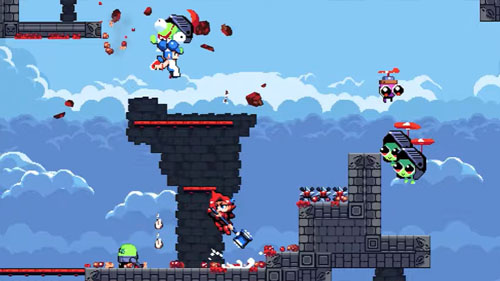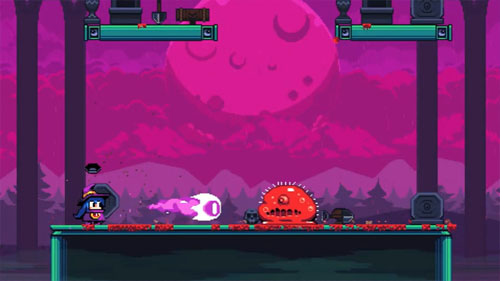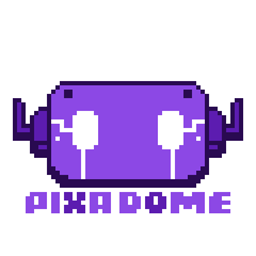A game by Pixadome for PC, Switch, PS4, Xbox One, and Xbox X/S, originally released in 2022.
Chenso Club is a roguelike actioner featuring arena-based melee combat. The game stars five super-powered heroines as they work together (sometimes reluctantly) to thwart an alien invasion, with each heroine bearing different movement and combat abilities. The game is extremely colorful and offers over-the-top enthusiastic violence with cutesy characters and enemies, as inspired by 90’s animated series like The Powerpuff Girls. While the premise and presentation are couched in silliness, there are occasionally some serious themes at play, and the Chenso Club won’t let anything stand in their way.When the game begins, a girl named Blue is seen floating in a cylindrical tank as government agents – complete with MIB-style suits and sunglasses – attempt to activate her to defend against the sudden invasion of UFO’s. They aren’t successful at first, but then one of the aliens is accidentally teleported into the tank of liquid and drowns. When it dies, its life force passes into Blue and awakens her, imbuing her with some kind of power.
Blue is one of five playable characters in an adventure that spans five themed areas, with one new character unlocked as each area is completed. The game is built around a roguelike formula where players are sent back to the start of the game when killed, losing all of their powerups in the process. However, players retain unlocked characters, and they can jump back into any themed area that they have previously visited. Players may bring a friend for local 2P co-op, and they may select between four difficulty levels: story, casual (default), standard, and insane.
It’s worth noting that enemies grow in strength with each area you complete, so there is a risk/reward factor as you decide whether to enter an earlier area to build up a stock of helpful items, or dive straight into the later challenges. Level layouts are randomized as well, per genre conventions, with each level acting as a single screen arena with an entrance on one side and an exit on the other, and the exit remains locked until all enemies are defeated.
Despite the differences in each character's movement speed and jump height, they all have fairly floaty jumps without much horizontal reach, and they have no wall jump or double jump (instead they have a 4-way dash). Players have very little midair direction control, and they cannot interrupt an attack animation with a jump, which makes jumping a bit sluggish. Unfortunately, this impacts the core experience as players must regularly run and jump through the environments to attack enemies.
Accompanying this issue are some odd choices when it comes to pacing. Players regularly encounter platforms that are just slightly too high for them to reach, which slows the pace with missed jumps, or adds extra steps as the player jumps, performs a vertical dash, and then falls back down to the desired platform... thus adding seconds to otherwise simple environmental traversal. Furthermore, each area consists of a series of short levels, but before players are able to enter a level, they must sit through a level/map transition screen (presumably masking the load time), after which they are dropped into an empty room that they must pass through before reaching a room with enemies. Boss levels start the player in these empty rooms as well, and even cutscenes won’t start playing without a button press from the player.
Brawler-based roguelikes are generally built around speed and efficiencey as players chain together movements and attacks – which is certainly supported here by the charismatic character designs and exuberant animations – but players will find themselves spending a lot of time waiting for the next bit of action to begin.
Blue is the best all-around character, with medium speed, strength, and defense. She has a high jump and a 3-hit combo that ends in a spinning chainsaw attack and lasts for a couple of seconds. Performing an upward attack while jumping allows her to hang in the air for a moment, which is useful for hitting enemies above her, and she can also strike downward with her chainsaw while jumping. Her special attacks include a spinning helicopter attack that propels her upward and does continuous damage to enemies above her, as well as a wheel attack that lets her roll quickly across the floor doing minor damage to enemies on the ground.
Blue can combine her dash maneuver and helicopter attack to reach any point in the environment, although the dash is expectedly speedier. She can transition from a helicopter attack into a dash and then into another helicopter attack (but not vice versa), making her a strong character for dealing with aerial threats. As with all characters, she can dash in four directions – during which time she is invulnerable – but she has the longest dash of them all.
Carmine is a castle guard who wields a gigantic spiked hammer, and she is the brute of the team. After she is humorously abducted while trying to explain her vast qualifications to Blue, she ends up needing Blue’s help to be rescued. Carmine is the slowest team member, and she has a short dash, but she makes up for this with high defense and maximum strength. She also has much better reach than blue, due to the size of her hammer, so while her attacks are slower, she is much better at taking down enemies that require multiple hits to destroy.
Carmine’s combo ends in a spinning hammer attack that continues for as long as the player mashes the button, wiping out the heaviest of foes – or crowds of them – and wearing down boss health bars quickly. She also has a special attack that allows her to send shockwaves outward to the left or right (or both at the same time), allowing her to do weak damage to enemies at a distance, even through walls. Her upward special attack doesn’t have the verticality of Blue’s but it offers a wide swath of heavy damage to any enemy it touches. The only place where she lacks strength is in her jump strikes, which are kicks instead of hammer swings, although she still uses her hammer when attacking upward or downward while jumping.
Plum is a witch… or at least a witch hobbyist, but she does use magic. She has average movement speed, low defense, and above average attack power. She just has a single strike rather than a combo, and her dash isn’t terribly impressive, but her strength lies in her spellcasting abilities. For one, she can perform a jumping special attack that results in a pair of black wings materializing at her side that do heavy damage to enemies, and she can summon a huge spiked ball that can be knocked into enemies to cause damage from a distance.
Plum’s most powerful spell is a long range projectile that can pass through multiple enemies at succession, allowing them to be instantly killed with her next strike. But the balance to all of this power is that using any one of these spells puts Plum into a cooldown mode until she attacks several enemies to refill the meter. As such, you won’t actually get to use her coolest abilities most of the time, and she isn’t as versatile as her partners in standard melee combat and environmental navigation.
Alice, the mountain climber, is the ace when it comes to speed and maneuverability, which makes up for some of the aforementioned shortfalls with the game's speed and pacing… although she doesn’t unlock until the back half of the game. She has the highest speed, lowest defense, and above average attack power. She has an infinite combo that lasts as long as the player taps the button, allowing her to tear through enemies on the ground or in the air, and when attacking in the air, she hangs for a moment, allowing for repeated strikes.
On top of this, Alice has a grappling hook that allows her to grab onto a wall or ceiling and pull herself to the left, right, or upward. This can also be done to grab enemies, allowing her to pull herself toward aerial foes, or even latch onto hard-to-reach weak points on bosses. This maneuverability, combined with quick powerful attacks, allows skilled players to close ground quickly, deliver heavy damage, and evade danger. Alice has a short dash, but it hardly matters when she can grab a wall halfway across the room and zip over to it.
Finally there is Molly, the firefighter, who is unlocked just before the player begins the march to the final boss… so she is most likely to be used on a repeated playthrough. Molly is the slowest of the bunch, but she has the highest defense, and medium strength, but what she brings to the table is the ability to fight from afar.
Molly has a water tank strapped to her back, which she uses to fire globs of water at enemies, taking them down from a distance. She can also rocket upward to strike enemies above her, or lob a powerful grenade… although all of these moves use up some of her water. The tradeoff for delivering long-range damage is the fact that Molly’s tank only holds a limited amount of water. Once she runs out, the player must mash a button to refill it, which can be tough in the heat of battle.
Players must contend with a variety of ground- and air-based enemies, along with projectile-tossing foes that are always a challenge in games that focus on melee combat. But success in battle means more than simply wiping out every enemy in the room; a successful strategy relies heavily on health management…
Roguelike actioners are notoriously stingy with health restoratives, which adds to the challenge and the player’s stress level. But unlike its genre brethren, this game hands out blood like candy. For starters, the player begins the game with 20 units of health, with most enemy attacks removing one or two units per strike. Secondly, most enemies drop a bit of blood when they are killed, and collecting this blood restores a single unit of health to the player. When the player character takes damage, a drop of blood is sometimes released, and collecting it allows the player to recover one lost unit of health. And there are occasions where killed enemies leave behind two drops of blood, or a big drop of blood with a heart in it that restores three units.
So with all this free blood flying around, where’s the challenge? Well, collecting that blood isn’t always easy, as it moves in a slow arc away from the defeated enemy, and the player only has a few seconds to grab it before it disappears. Often, running after a floating drop of blood can put the player at a higher risk of taking damage, thus adding a bit of risk and reward. It’s also possible to destroy these floating globs of sanguine goodness by hitting them with your own attacks, which happens often when you’re swarmed by baddies.
Per genre conventions, it’s possible to increase your stats, as well as purchase or otherwise unlock items to aid you in your current run. Sometimes after you’ve cleared a room, a shop will appear, and you can go inside to trade your precious blood for items, essentially sacrificing your health for a potential combat advantage. Other times, items can be earned by completing challenges, such as taking allowing a fortune teller to temporarily make you and your enemies deal more damage, of fighting through a level or two in the dark (although sometimes you get these reward without actually having to face any enemies, which seems to be an oversight in how the game randomizes its encounters).
Other challenges include killing enemies to keep a timer from reaching zero, clearing out a room full of garbage, or spinning a wheel of fortune. Sometimes after clearing a level, a “cool bus” shows up and transports the player to a bonus level. Here the player must complete a series of platforming challenges or a multi-wave combat arena to fill a container with blood. There are three prizes of increasing value based on how full the container gets, and hitting the max grants the player all three prizes.
Rewards include stat boosts for health, defense, speed, and attack power, along with spinning sawblades that damage enemies and protect you from attacks, a shield that protects you from one hit, increased stun duration for your enemies, and the ability to make blood explode when you attack it, sending out a projectile in the direction of a nearby target. There are some active-use items such as a boomerang, a support companion that fires projectiles, and a shockwave that stuns enemies and pushes them away from you, and these have varying cooldown periods. Most passive powerups are stackable, so you can collect more than one to increase their number, duration, etc. One particularly deadly combination is getting powerups to increase your number of dashes, along with a powerup that lets you do damage to enemies while dashing, which allows you to move quickly and deal damage while remaining invulnerable for much of that time.
Boss encounters aren’t terribly exciting, as they cycle through the same few attacks over and over while you try to work down their giant life bars. The real challenge is that bosses can take off quite a lot more damage than regular enemies, so it’s possible to get killed quickly if you don’t avoid their strongest attacks… or take multiple hits as you are damaged and pushed into level hazards. Defeating a boss allows you to select between increased attack strength or 20 more units of max health. Your health is not restored upon beating a boss, so if you limp your way to the end of the battle, you may find yourself killed quickly in the next area.
Adding a bit of charm to the experience is a social media element, which plays out on a Twitter-inspired platform called Chirp. Defeating bosses and completing challenges earns you new followers – including some of the very people who offered the challenges – which in turn opens a shop where you can unlock better drops for future runs, like poison swords, chain lightning, a time stopper, and the ability to deflect projectiles. Also, every time you finish an area, you get to play through a celebratory sequence where you are swarmed by your adoring fans while you do your best to fight them off. You must perform a variety of attack types while staying within the frame of the paparazzi’s camera for maximum exposure on social media, and even more followers, which adds another layer to the game’s silly humor.
2D CRED
Chenso Club was developed by Pixadome, a studio based in Sweden and founded in 2017. The studio previously developed Hayfever. Music for the game was composed by by Kristoffer Engman, a.k.a. Knasibas, who previously composed music for Hayfever and Lunistice. The studio is part of the Aurora Punks collective, which provides talent and funding to its associated indie studios, which includes of Pixadome, Upstream Arcade, Simon Bäckström, and Last Credit Games. The collective previously produced 1993 Space Machine, Kung Fury: Street Rage, and Hoplegs - Spread Your Legs Bundle.
The game was published by Curve Games, a studio based in London and founded in 2005. The studio previously published The Swapper, Velocity Ultra, The Swindle, Stealth Inc. 2, Serial Cleaner, Hue, and numerous other games.












































0 comments:
Post a Comment